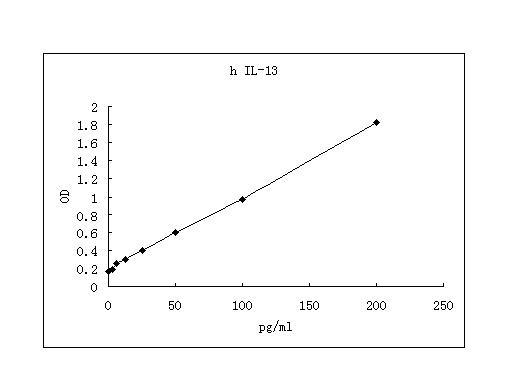Detect Range: 3.125-200pg/ml
Sensitivity: 1pg/mL
Sample Type: Cell culture supernatant, serum, plasma (EDTA, citrate, heparin)
Sample Volume: 20 uL
Assay Time: 3 hours
Detection method: Colorimetric

Interleukin-13 (IL-13) is a 17 kDa immunoregulatory cytokine that plays a key role in the pathogenesis of allergy, cancer, and tissue fibrosis (1-3). It is secreted by Th1, Th2, Th17, NK, and mast cells, visceral smooth muscle cells, eosinophils, and basophils (2, 4). This pattern is similar to the expression of Interleukin-4 (IL-4) but also includes subsets of Th1 and Th17 cells that do not secrete IL-4 (5). IL-13 circulates as a monomer and has two internal disulfide bonds that contribute to its bundled four α-helix configuration (6, 7). Mature human IL-13 shares approximately 58% amino acid sequence identity with mouse and rat IL-13. Despite the low homology, it exhibits cross-species activity between human, mouse, and rat (8, 9). IL-13 suppresses the production of proinflammatory cytokines and other cytotoxic substances by macrophages, fibroblasts, and endothelial cells. On B cells, it promotes cellular activation, immunoglobulin class switching to IgE, and the upregulation of CD23/Fcε RII. Polymorphisms and upregulation of IL-13 are associated with atopy, asthma, airway hyperresponsiveness, and tissue fibrosis (1, 10).
The biological effects of IL-13 and IL-4 are closely related due in part to a shared receptor system. IL-13 binds with low affinity to the transmembrane IL-13 Rα1 which then forms a signaling complex with the transmembrane IL-4 Rα (11-13). This high affinity receptor complex also functions as the type 2 IL-4 receptor (11, 12). Soluble forms of IL-4 Rα are expressed which retain ligand binding properties and inhibit IL-4 bioactivity (14, 15). IL-4 Rα also associates with the common gamma chain (γc) to form the type 1 IL-4 receptor complex (16, 17).
Additionally, IL-13 binds with high affinity to IL-13 Rα2 which is expressed as cell surface and soluble forms (18-20). IL-13 Rα2 functions as a decoy receptor by preventing IL-13 from signaling through the IL-13 Rα1/IL-4 Rα complex (21, 22). It also inhibits responsiveness to IL-4 by blocking signaling through IL-4-occupied IL-13 Rα1/IL-4 Rα receptor complexes (22, 23). IL-13 Rα2 is upregulated during Th2-biased immune responses and limits inflammatory tissue damage (20, 24, 25). Aside from its decoy function, IL-13 Rα2 can signal in response to IL-13 to directly promote tumor cell invasiveness and the development of tissue fibrosis (26-28).
Townley, R.G. et al. (2011) Discov. Med. 12:513.
Wynn, T.A. (2003) Annu. Rev. Immunol. 21:425.
Joshi, B.H. et al. (2006) Vitam. Horm. 74:479.
McKenzie, A.N. et al. (1993) Proc. Natl. Acad. Sci. USA 90:3735.
Gallo, E. et al. (2012) Eur. J. Immunol. 42:2322.
Moy, F.J. et al. (2001) J. Mol. Biol. 310:219.
Eisenmesser, E.Z. et al. (2001) J. Mol. Biol. 310:231.
Ruetten, H. and C. Thiemermann (1997) Shock 8:409.
Lakkis, F.G. et al. (1997) Biochem. Biophys. Res. Commun. 235:529.
Liu, Y. et al. (2012) Front. Immunol. 3:1.
Aman, M.J. et al. (1996) J. Biol. Chem. 271:29265.
Zurawski, S.M. et al. (1995) J. Biol. Chem. 270:13869.
Andrews, A.L. et al. (2002) J. Biol. Chem. 277:46073.
Kruse, S. et al. (1999) Int. Immunol. 11:1965.
Jung, T. et al. (1999) Int. Arch. Allergy Immunol. 119:23.
Kondo, M. et al. (1993) Science 262:1874.
Russell, S.M. et al. (1993) Science 262:1880.
Chen, W. et al. (2008) J. Allergy Clin. Immunol. 122:625.
Chen, W. et al. (2009) J. Immunol. 183:7870.
Daines, M.O. et al. (2007) J. Allergy Clin. Immunol. 119:375.
Kasaian, M.T. et al. (2011) J. Immunol. 187:561.
Andrews, A.-L. et al. (2006) J. Allergy Clin. Immunol. 118:858.
Rahaman, S.O. et al. (2002) Cancer Res. 62:1103.
Sivaprasad, U. et al. (2010) J. Immunol. 185:6802.
Chiaramonte, M.G. et al. (2003) J. Exp. Med. 197:687.
Fujisawa, T. et al. (2009) Cancer Res. 69:8678.
Fujisawa, T. et al. (2011) Int. J. Cancer 131:344.
Fichtner-Feigl, S. et al. (2006) Nat. Med. 12:99.
My Review
© 2017, AbSci All Rights Reserved. E-mail: info@abscitech.com
南京川博生物技术有限公司版权所有
苏B1-20150380 苏ICP备15009006号-1